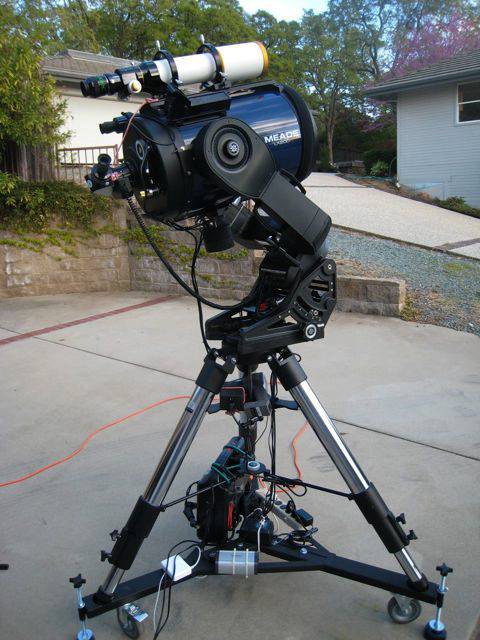| Prior to having an observatory, I rolled my telescope set-up out to the driveway on wheely bars. This system worked well, but I still had to perform a polar alignment every time I brought the telescope out. This took time (1-2 hours to really get accurate), and was a pain. |  |
 | I mounted all of the electronics on the base of the wheely bar, so that everything could remain connected. There was a single power cable (orange, to the left of the tripod in the photo at left) coming into a Digital Loggers remote power controller, which had an ethernet cable (white) connected, so that I could independently turn on and off all of the electronics. The Dell laptop was connected to my LAN via WiFi, so the entire system could really operate on a single AC cable. (if I wanted, I could have used a battery and inverter to get the entire system to be wireless). The limiting factor in the alignment was putting the feet onto marks drawn on the driveway. Although I could usually place it to 5-10 arcminutes accuracy, I really wanted to get the polar alignment to 2-3 arcminutes, so that I could image immediately. In addition, the thin bolts used as legs caused the entire set-up to wobble - especially if there was a high wind. As solid as everything else was, these bolts were the limiting factor in the stability of the system. |
Therefore, I designed a simple system that could allow me to place the telescope on the driveway with high accuracy alignment. This was going to be just 2" bar stock that I cut and drilled holes into. However, the machine shop that I went to did a much nicer job - actually machining a radius on both the longer rod and the lower piece, so that the ball bearing fits perfectly, and no 'galling' will occur over time (although the number of uses is quite limited). The lower piece is only 1/2" (1.25 cm) high, so that cars can roll over it. It is epoxied to the driveway. Then, a 1" (2.5 cm) ball bearing is placed into the hole. Finally, the wheely bar is rolled out, and the new 2" diameter legs (with a hole for the ball bearing) are lifted up and set onto the ball bearings. |  |
 | Other than having to lift around 100 lbs (45 Kg), it turned out to be a neat system. I could routinely obtain alignment in the range of 1-2 arcminutes. Much better accuracy could probably be achieved, if I strengthened the wheely bar by welding braces (as the wheely bar twists under the heavy load). In fact, I would guess that I could get the alignment down to around 15-20 arcseconds (i.e., roughly the same as the Paramount ME all-sky pointint error with a good tPoint model). |
| As the driveway is not level, it was a challenge to get the lengths of the new legs right - too long and they would drag on the driveway (or prevent the wheely bar from rolling); too short, and they wouldn't lift the wheely bar off of its wheels. So there is very little clearance when rolling the wheely bar and when it is sitting on the driveway bases - but it works! |  |
I am not aware of anyone else having made such a mount set-up. I would consider offering it for sale, but the maching costs would be prohibitive, requiring a selling price of a few hundred dollars (!). Obviously, if I had a large number of these machined on CNC equipment, the cost (and price) could come down ... but I doubt that there would be that much interest in such a system.
|